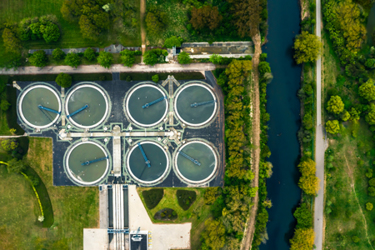Benchmarking As A Tool To Optimize Operations And Lower GHG Emissions
By Mette Madsen

The US Water Alliance is getting lessons from Denmark, where benchmarking has proven to be a useful tool in becoming one of the world’s most efficient water sectors, to help optimize processes and meet climate goals.
The race to net zero is a global challenge in the water sector. Technology and digitalization are important tools to reduce energy use and water loss, but collecting data is also an important part of implementing high technology solutions to further digitalization and prioritize efforts and investments.
Benchmarking is a tool that can uncover the potential for optimization for the utilities and enable data-driven decision-making by collecting a wide range of data from water utilities’ operations, analyzing them, and publishing a report where the utilities are benchmarked across various economic and performance data points such as water loss, energy use, and investments.
“From decades of using benchmarking in the Danish water sector, we have learned that water utilities can use the data to exchange experiences with competitive partners and to make smart decisions regarding everything from contracts to investments. Knowledge sharing is essential, both locally and globally. We are experiencing great interest in Danish experiences and solutions in the U.S., which we are facilitating through our Water Technology Alliance and our partnership with the US Water Alliance and the [Danish] Water and Wastewater Association,” said Consul General of Denmark in Chicago and head of water, Jesper Køks Andersen.
Benchmarking Is An Integrated Part Of Optimizing The Danish Water Sector
The Danish water sector has utilized benchmarking for decades. It began with voluntary benchmarking initiated in 1999 by eight water utilities who wanted to compare themselves to each other, and in 2003 the first IT platform was launched to report data for benchmarking. In 2010, a water sector act was adopted in Denmark to ensure that water utilities have high environmental quality, that they consider nature and security of supply, and are run in an efficient and transparent way.
With that, economic benchmarking was introduced, and in 2011 it was implemented, to imitate market competition in the monopoly that naturally exists in the water sector. Through economic incentives such as revenue caps, the purpose of economic benchmarking is for all utilities to become as economically efficient as the most efficient utilities in the sector, and in that way protect consumers from high prices.
The law covers all municipally owned water and wastewater utility companies, as well as private-public water utility plants, that sell more than 53 million gallons yearly flow. Revenue caps are yearly efficiency requirements on total revenue, both operational and capital, of 2% maximum. Companies that sell over 211 million gallons are subject to individual efficiency requirements that are based on efficiency potential.
When economic benchmarking was first established, focus was on reducing the operational budget. However, in 2016 the act was updated to encompass both operational and capital expenses to ensure that the utilities make efficient and long-term investments, for example in technology and infrastructure. Another form of benchmarking conducted by the Danish Environmental Protection Agency (EPA) was also incorporated, performance benchmarking, which involves non-economic parameters such as health, environment, and energy.
The three types of benchmarking — voluntary, performance, and economic — are all utilized in the Danish water sector today and conducted by three different entities. The Danish Water and Wastewater Association (DANVA), a national nonprofit industry and stakeholder organization for Denmark’s drinking water and wastewater utilities, handles the voluntary benchmarking, the Danish Competition and Consumer Authority is responsible for the economic benchmarking, and the Danish EPA conducts performance benchmarking. The data for benchmarking are reported once a year by the utilities into one system, from which the relevant data are shared with the organizations responsible for the respective benchmarking.
Three Types Of Benchmarking In The Danish Water Sector
- Economic benchmarking is mandatory by law and involves the overall economy. It is conducted by the Danish Competition and Consumer Authority, which is an independent public authority. It involves economic incentives, such as revenue caps, to make utilities run as efficiently as possible.
- Performance benchmarking is also mandatory and conducted by the Danish Environmental Protection Agency. It measures non-economic parameters within health, the environment, and climate.
- Voluntary benchmarking also looks at the economy, but in more detailed subcategories covering the entire cycle from utility to consumer and nature, including employee sick leave, water loss, bursts on distributions pipes, energy, planned and budgetary investments, groundwater protection, and discharge from wastewater treatment plants to the aquatic environment. It is conducted by the Danish Water and Wastewater Association.
“The benchmarking report submission is highly based on mutual trust. The economic benchmarking has requirements for documentation, and DANVA and the Danish EPA trust that the utilities’ data reports are factual. It is the same numbers that they use for their annual business reports that they present to their boards,” said Thomas Sørensen, manager of data application at DANVA.
Sharing Knowledge Is Imperative
Every year, DANVA presents an overview of benchmarking through their publication Water In Figures, which presents the numbers, takeaways, and developments in the Danish water sector’s operations to foster knowledge-sharing and learning for the best.
“The voluntary benchmarking provides deeper insights into what separates the utilities from one another. From our report for sludge handling, utilities can see if their colleagues have found a smart solution they can learn from, such as the ideal length of contracts, prices for sludge disposal, or the benefits of having an internal sludge storage,” said Thomas Sørensen, Manager of Data Application at DANVA.
Aarhus Vand is a Danish water company that utilizes benchmarking to optimize their operations and ensure long-term planning and financing. In the first years of collecting data, it was a considerable task for the company. However, with time the process has become highly automated and easy to complete.
“We have an interest in knowing these numbers. Benchmarking can provide us with targets to pursue. There is consensus in the Danish water sector that we want to be measured and perform and improve on central aspects, such as water loss and energy use. We cannot optimize based solely on the figures; discussing the findings with other companies is imperative. It is the community in the Danish water sector taking part in benchmarking and setting common goals that drives the sector,” said Søren Larsen, subject manager of asset management in Aarhus Vand.
Claus Homann, chief operations officer and chief of strategic development in Aarhus Vand, added:
“We have a cooperation of like-minded companies, where we look at the benchmarking report together to discuss if there are areas where we can become smarter and better. That shows some of the great strength in the Danish water sector: openness and cooperation.”
Benchmarking In The U.S. Water Sector
Benchmarking also exists in the U.S., through, for example, the American Water Works Association’s Utility Benchmarking Program. However, there is no current national blueprint or regulatory drivers for benchmarking. In 2022, the US Water Alliance launched a cohort of 10 utilities from across the U.S. with the goal of accelerating equitable climate mitigation strategies and meeting greenhouse gas (GHG) reduction goals at water and wastewater utilities. The cohort is establishing a collaborative approach, sharing knowledge between the utilities for them to find solutions to reduce energy use and water loss, among other things.
“Participants in the cohort are eager to share and learn from one another about their approaches, and we are working closely with Brown and Caldwell to develop a maturity model that will enable utilities to self-assess their GHG reductions efforts and voluntarily benchmark with one another. We plan to build off this as interest grows and deepen our climate mitigation work in 2023,” said Renée Willette, vice president of programs and strategy at the US Water Alliance.
Through a partnership between the US Water Alliance, DANVA, and the Embassy of Denmark in Washington, D.C., the partners share experiences, solutions, and innovations to reach net zero in the water sector — a benefit both for the utilities in terms of reducing operational and capital expenses and the planet in terms of reducing GHG emissions.
In November, the US Water Alliance and their cohort traveled to Denmark for an inspirational tour of the Danish water sector, where they also had the possibility to exchange knowledge on benchmarking.
“At the national scale, the Danish water-sector-wide goal for net zero and Denmark’s national benchmarking system is an inspiration for many of us here in the United States. One of the greatest lessons we can learn from the Danish water sector is that, when done collaboratively, benchmarking can provide both mutual support and friendly competition that helps individual utilities and the entire sector succeed together,” said Willette.
 About The Author
About The Author
Mette Madsen is the marketing and communications advisor for the Trade Council of Denmark in North America — Energy and Environment. The Trade Council helps small and large enterprises to foster innovation, start exporting, and expand their activities to new markets. Mette earned a Master of Arts in communication studies and global studies from Roskilde University in Denmark and currently resides in Chicago, IL.
